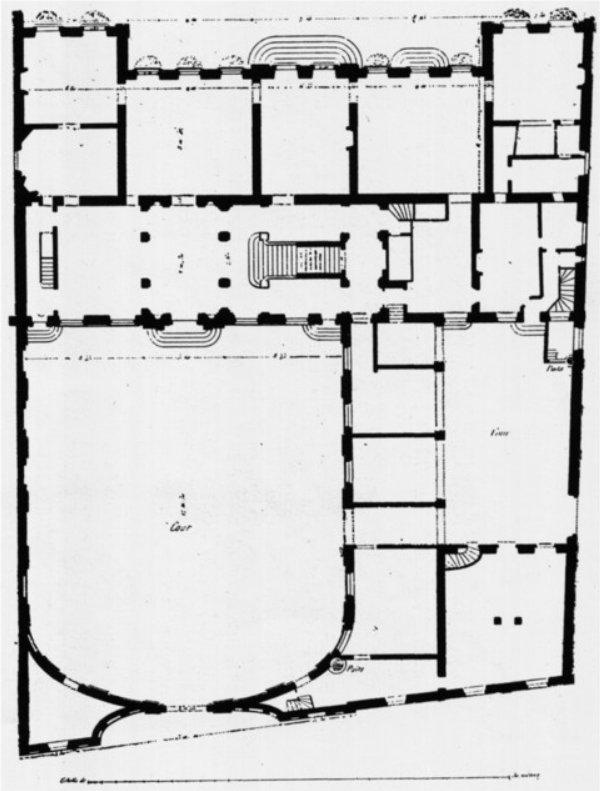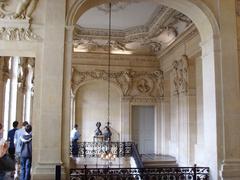
Musée Picasso Paris: Visiting Hours, Tickets, and In-Depth Guide to Paris’s Art and History
Date: 14/06/2025
Introduction
Nestled in the heart of Paris’s Marais district, the Musée Picasso Paris is a world-renowned destination for art lovers and cultural explorers. Housed in the grand 17th-century Hôtel Salé, the museum boasts the most extensive public collection of Pablo Picasso’s works, spanning his entire career and offering unique insight into his creative process. More than a museum, it is a vibrant research and cultural center, presenting not only Picasso’s art but also his personal archives, and exploring the evolution of modern art in a historic Parisian setting. This guide details everything you need to know, from visiting hours and ticketing to exhibition highlights, accessibility, travel tips, and frequently asked questions.
Table of Contents
- Introduction
- Historical Background and Museum Genesis
- The Significance of the Musée Picasso
- Essential Visitor Information
- Visitor Tips and Nearby Attractions
- Frequently Asked Questions (FAQ)
- Visuals and Media Recommendations
- References and Further Reading
- Conclusion and Call to Action
Historical Background and Museum Genesis
Hôtel Salé: From Private Mansion to Cultural Landmark
The Musée Picasso is housed in the Hôtel Salé, an architectural masterpiece built between 1656 and 1660. Originally owned by Pierre Aubert, the building’s ornate façade and grand interiors reflect the opulence of 17th-century French baroque style. Over centuries, it served diverse roles—from embassy to school—before being classified as a monument historique in 1968 (snippetsofparis.com). Purchased by the City of Paris in 1974, the Hôtel Salé underwent a meticulous restoration to prepare for its transformation into a museum (obonparis.com, paristouristinformation.fr).
The Birth of the Musée Picasso
Pablo Picasso (1881–1973), though Spanish by birth, spent much of his artistic life in France, profoundly influencing and being influenced by its art scene. Upon his death, his heirs used the “dation en paiement” law to settle inheritance taxes by donating thousands of his works to the French state. This unprecedented collection formed the core of the Musée Picasso, which opened its doors in 1985. The museum continues to expand through further donations and acquisitions, making it a living repository of Picasso’s legacy (thegeographicalcure.com, wikipedia.org).
Restoration and Expansion
A major renovation from 2009 to 2014 modernized the museum, improved accessibility, and expanded exhibition spaces. The Musée Picasso now offers five floors and 37 galleries, allowing for comprehensive displays of its vast collections and regular rotation of works (thegeographicalcure.com).
The Significance of the Musée Picasso
Artistic and Cultural Impact
With over 5,000 works—paintings, sculptures, ceramics, drawings, prints, and photographs—the Musée Picasso is the largest and most comprehensive collection of Picasso’s art worldwide. The museum’s displays cover every phase of Picasso’s prolific career, from his early Blue and Rose Periods, through Cubism, Neoclassicism, Surrealism, and his later experimental years (paristouristinformation.fr). The institution also functions as a center for research, education, and international exchange, hosting major temporary exhibitions that connect Picasso’s work to wider historical and cultural narratives, such as the 2025 “Degenerate Art” exhibition (sortiraparis.com).
Picasso’s Personal Collection and Influences
In addition to his own creations, the museum features works by artists who influenced Picasso or whom he admired, including Cézanne, Degas, Matisse, Braque, and Gauguin. The collection also contains Iberian bronzes, African masks, and Oceanic artifacts, reflecting the breadth of Picasso’s inspirations (paristouristinformation.fr). The museum’s archives include personal correspondence, sketchbooks, and photographs, offering a comprehensive look at Picasso’s creative process and private life.
Essential Visitor Information
Location and Access
- Address: 5, rue de Thorigny, 75003 Paris, in the Marais district (official museum site).
- Metro: Saint-Paul (Line 1) and Chemin Vert (Line 8).
- Bus: Lines 29, 75, and 96.
- Nearby Attractions: Place des Vosges, Carnavalet Museum, Saint-Paul-Saint-Louis Church, and the vibrant Marais neighborhood.
Visiting Hours and Ticketing
- Hours:
- Tuesday to Friday: 9:30 a.m. – 6:00 p.m.
- Saturday and Sunday: 9:30 a.m. – 6:00 p.m.
- Closed Mondays, January 1, May 1, and December 25 (official museum site).
- Extended Hours: First Wednesday of each month until 10:00 p.m. (confirm on official website).
- Tickets:
- General admission: €14–€16
- Free admission for visitors under 18, EU residents under 26, and on the first Sunday of each month
- Advance online booking is strongly recommended, with timed-entry slots every 30 minutes (obonparis.com, Miss Tourist)
- Paris Museum Pass holders may enter for free
- Audio Guides: Available for a small fee until 3:00 p.m. daily.
Museum Facilities and Accessibility
- Cloakroom: Free for ticket holders; large bags/luggage are not permitted in galleries.
- Restrooms: Available on the ground floor.
- Museum Shop: Offers Picasso-themed books, prints, and souvenirs.
- Café: “Le Café sur Le Toit” on the rooftop, with views over the Marais (Paris Insiders Guide).
- Garden: Open from April to mid-October.
- Accessibility: Fully accessible to visitors with reduced mobility, with elevators and adapted restrooms. Wheelchairs available on request.
Notable Works and Exhibition Highlights
- Masterpieces on Display:
- Blue Period: “Self-Portrait,” “La Célestine,” “Death of Casagemas”
- Cubism: Still Life with Chair Caning, Man with Guitar
- Surrealism & Later Works: “The Kiss,” “Large Nudes,” “Matadors and Musicians”
- Iconic Sculptures: Woman in the Garden, Bull’s Head, Man with Sheep
- Personal Archives: Sketchbooks, letters, and photographs providing insight into Picasso’s life.
- Contemporary Installations: Works by artists such as Guillermo Kuitca and Anna Maria Maiolino create a dialogue between Picasso and contemporary art (official exhibitions page).
Special Exhibitions and Events
- Permanent Collection: “La Collection : Revoir Picasso” (through March 12, 2027) presents the museum’s holdings with fresh thematic and chronological arrangements.
- Temporary Exhibitions:
- “Anna Maria Maiolino: I Am Here. Estou Aqui.” (June 14 – September 21, 2025)
- “Guillermo Kuitca, Chapelle” (October 15, 2024 – December 31, 2027)
- Major Past Exhibitions: “Celebration Picasso: The Collection in a New Light” (2023), “Degenerate Art: The Trial of Modern Art under Nazism” (2025) (sortiraparis.com)
- Guided Tours and Workshops: Available in several languages; workshops for children and families encourage creative engagement.
Visitor Tips and Nearby Attractions
- Best Times to Visit: Early mornings on weekdays are quieter; Thursday evenings offer a unique ambiance.
- Book Early: Secure tickets online to guarantee your preferred time slot (Miss Tourist).
- Travel Light: Only small bags are allowed inside; use the cloakroom for coats and umbrellas.
- Combine Your Visit: Plan time to stroll through the Marais, visit Place des Vosges, and explore local cafés and boutiques.
- Check Exhibition Listings: Exhibitions rotate regularly—consult the official website for updates.
Frequently Asked Questions (FAQ)
Q: What are the Musée Picasso Paris opening hours?
A: Tuesday–Sunday, 9:30 a.m.–6:00 p.m. (last admission 5:15 p.m.), closed Mondays and select holidays.
Q: How can I buy Musée Picasso tickets?
A: Purchase tickets online (recommended) or at the museum. Online booking includes a €1 fee per ticket but secures timed entry.
Q: Is the museum accessible for wheelchair users?
A: Yes, the museum is fully accessible with elevators, adapted restrooms, and wheelchairs available.
Q: Are guided tours and audio guides available?
A: Yes, guided tours in multiple languages and audio guides are offered.
Q: Is there a café or shop on site?
A: Yes, a rooftop café and museum shop are available during museum hours.
Q: Can I take photos inside the museum?
A: Non-flash photography is permitted in some areas; always follow posted guidelines and staff instructions.
Visuals and Media Recommendations
- Images: View high-resolution photos of the Hôtel Salé, Picasso’s masterpieces, and the museum’s interiors on the official website.
- Virtual Tours: Explore the museum layout and select collections online.
- Maps: Downloadable maps of the Marais district and museum floor plans are available for planning your visit.
References and Further Reading
- Musée Picasso Paris Official Site
- Opening Times and Visitor Access
- Obon Paris Guide
- Paris Tourist Information
- The Geographical Cure
- Miss Tourist
- The Tour Guy
- Sortir à Paris
- Paris Insiders Guide
- Paris Update
- City Paris
Conclusion and Call to Action
The Musée Picasso Paris is a cornerstone of the city’s cultural landscape, offering a profound journey through the genius of Picasso in an extraordinary historical setting. By planning ahead, booking tickets online, and exploring both permanent and temporary exhibitions, visitors can ensure a rewarding experience. Don’t forget to enhance your museum adventure with the Audiala app—audioguides, expert commentary, and up-to-date event information at your fingertips. For more guidance on Paris’s art scene, explore our related articles and stay connected with the museum via its official website and social media channels.





































































































































































































































